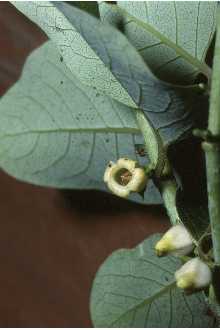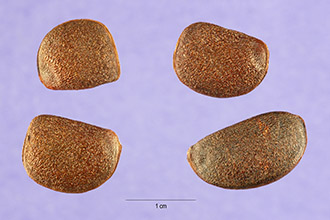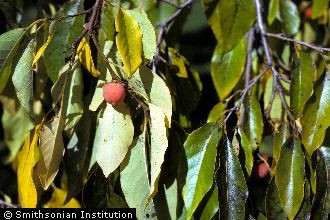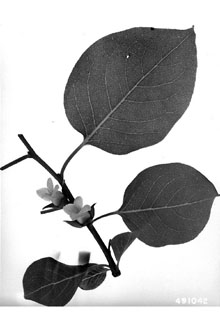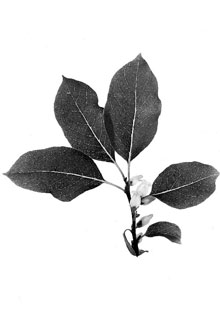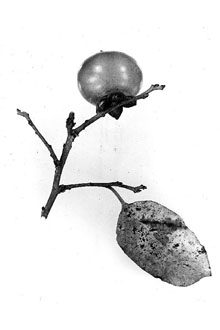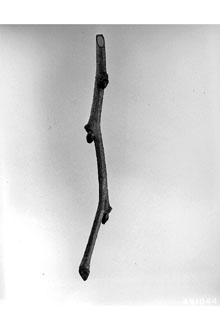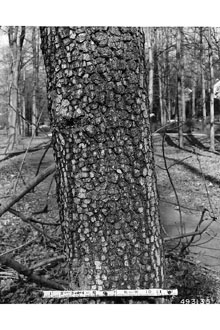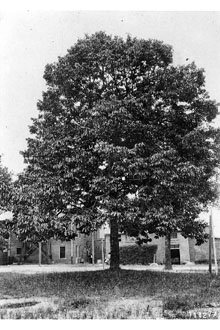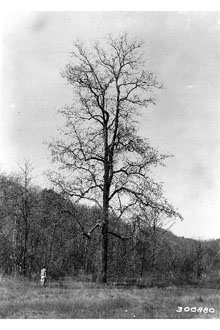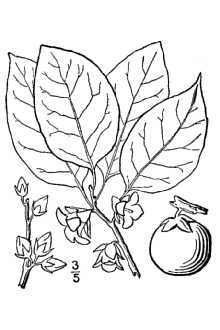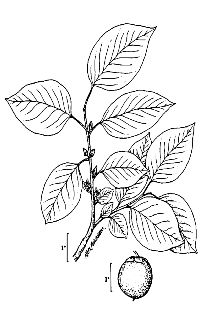Diospyros virginiana L. var. platycarpa Sarg.
Scientific Name: Diospyros virginiana L. var. platycarpa Sarg.
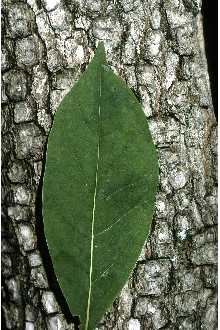
| General Information | |
|---|---|
| Usda Symbol | DIVIP2 |
| Group | Dicot |
| Life Cycle | Perennial |
| Growth Habits | Tree |
| Native Locations | DIVIP2 |
Plant Guide
Alternate Names
Eastern persimmon, possumwood, American ebony, white ebony, bara-bara, boa-wood, butterwood
Uses
Common persimmon is sometimes used as an ornamental for its hardiness, adaptability to a wide range of soils and climates, and immunity from disease and insects, Moist, well-drained soils provide best conditions but the plant will tolerate hot, dry, poor soils, including various city conditions, The species is rarely sold commercially, however, Use soil moisture sensors to measure the soil moisture of Diospyros virginiana L. var. platycarpa Sarg.., The leaves are glossy and leathery and may be yellow or reddish-purple in the fall, Several cultivars have been selected primarily for fruit color, taste, size, and early maturation; several are seedless, Budded or grafted trees are a sure way of getting a desired type, Common persimmon sends down a deep taproot, which makes it a good species for erosion control but makes it difficult to transplant, The wood of common persimmon is hard, smooth, and even textured, The hardness and shock resistance make it ideal for textile shuttles and heads for driver golf clubs, The heartwood is used for veneer and specialty items, but most of commercially used persimmon is reported to consist of sapwood, Robert H, Mohlenbrock USDA, NRCS, Wetlands Science Institute @ PLANTS Unripe fruit and inner bark have been used in the treatment of fever, diarrhea, and hemorrhage, The fruits are used in puddings, cookies, cakes, custard, and sherbet; the dried, roasted, ground seeds have been used as a substitute for coffee, Flowers produce nectar significant for bees in honey production, Leaves and twigs of common persimmon are eaten in fall and winter by white-tailed deer, The fruit is eaten by squirrel, fox, skunk, deer, bear, coyote, raccoon, opossum, and various birds, including quail, wild turkey, cedar waxwing, and catbird,
Status
Please consult the PLANTS Web site and your State Department of Natural Resources for this plant’s current status, such as, state noxious status and wetland indicator values.
Description
General: Ebony family (Ebenaceae). Native trees growing 5-12 (-21) meters tall; mature bark dark-gray, thick and blocky. Leaves are deciduous, simple, alternate, ovate to elliptic or oblong with smooth edges, 3.5-8 cm long, with an acuminate apex and rounded base, the lower surface usually lighter-colored, especially on young leaves. Flowers are either male (staminate) or female (pistillate), borne on separate trees (the species dioecious) on shoots of the current year after leafing; pistillate flowers solitary, sessile or short-stalked, bell-shaped, ca. 2 cm long, the corolla creamy to greenish-yellow, fragrant, usually with 4 thick, recurved lobes; staminate flowers in 2-3-flowered clusters, tubular, 8-13 mm long, greenish-yellow. Fruit is a berry 2-5 cm wide, greenish to yellowish with highly astringent pulp before ripening, turning yellowish-orange to reddish-orange and sweet in the fall, each fruit with 1-8 flat seeds. The common name, persimmon, is the American Indian word for the fruit. Variation within the species: variants have been described but are not generally formally recognized. Var. pubescens (Pursh) Dipp. - Fuzzy persimmon Var. platycarpa Sarg. - Oklahoma persimmon Var. mosieri (Small) Sarg. - Florida persimmon Distribution: Primarily a species of the east-central and southeastern U.S., with the southeast corner of its range in Texas, reaching northeast to New York and southern Connecticut, westward through southern Ohio, Indiana, and Illinois to Missouri and southeastern Kansas. It does not grow in the main range of the Appalachian Mountains nor in much of the oak-hickory forest of the Allegheny Plateau. For current distribution, please consult the Plant Profile page for this species on the PLANTS Web site.
Adaptation
Common persimmon grows over a wide range of conditions from dry, sterile, sandy woodlands to river bottoms to rocky hillsides. Growth is best on terraces of large streams and river bottoms with clays and heavy loams; usual sites in the Mississippi Delta are wet flats, shallow sloughs, and swamp margins. It thrives in full sun but also is shade-tolerant and can persist in the understory. It is an early pioneer on abandoned and denuded cropland and is common on roadsides and fencerows. Common persimmon often is seen as thickets (derived from root suckers) in open fields and pastures. This species flowers in March-June and fruits in September-November.
Establishment
Fruit may be produced by 10-year-old trees but optimum fruit-bearing age is 25-50 years. Good fruit crops are borne every 2 years. Seeds are dispersed by birds and animals and by overflow water in bottomlands. Persimmon is slow growing and usually does not make a large tree, although it may reach 21-24 meters tall on optimal sites. Trees have been reported to reach 150 years of age.
Management
Common persimmon usually is considered undesirable by growers of closely managed timber stands. It has been controlled by prescribed burns but is also known to decrease with fire exclusion. Roots and rootstocks are killed by severe fires that char the soil; less severe fires top-kill the plant. Vigorous sprouts are produced from the root collar following top-kill by fire or after cutting. Deer occasionally browse the sprouts but cattle usually avoid them. Thickets from root suckers and collar sprouts in pastures may be problematic. Various herbicides are used to kill the plants. The principal natural defoliators of common persimmon are the webworm (Seiarctica echo) and the hickory horned devil (Citheronia regalis). Small branches severed by a twig girdler (Oncideres cingulata) are often encountered – these wounds allow entry of a wilt fungus, Cephalosporium diospyri, which kills many trees in the southeastern US. An infected tree lives 1-2 years after the wilting appears. Diseased trees should be burned and bruises on healthy trees should be covered with pitch or wax to prevent entry by wind-borne spores. Cultivars, Improved and Selected Materials (and area of origin) Contact your local Natural Resources
Conservation
Service (formerly Soil Conservation Service) office for more information. Look in the phone book under ”United States Government.” The Natural Resources Conservation Service will be listed under the subheading “Department of Agriculture.”
References
Anonymous. 1973. Persimmon, Diospyros virginiana. Morton Arbor. Quart. 9:14-15. Coladonato, M. 1992. Diospyros virginiana. IN: W.C. Fischer (compiler). The fire effects information system [Data base]. USDA, Forest Service, Intermountain Research Station, Intermountain Fire Sciences Laboratory, Missoula, Montana. <http://www.fs.fed.us/database/feis/> Crandall, B.S. & W.L. Baker 1950. The wilt disease of American persimmon caused by Cephalosporium diospyri. Phytopath. 40:307-325. Glasgow, L.L. 1977. Common persimmon. Pp. 103-104, IN: Southern fruit-producing woody plants used by wildlife. USDA, Forest Service, General Report SO-16. Southern Forest Experiment Station, New Orleans, Louisiana. Halls, L.K. 1990. Diospyros virginiana L. Persimmon. Pp. 294-298, IN: R.M. Burns and B.H. Honkala (tech. coords.). Silvics of North America. Volume 2. Hardwoods. USDA, Forest Service Agric. Handbook 654, Washington, D.C. <http://willow.ncfes.umn.edu/silvics_manual/Table_of_contents.htm> McDaniel, J.C. 1973. Persimmon cultivars for northern areas. Fruit Var. J. 27(4):94-96. Spongberg, S.A. 1977. Ebenaceae hardy in temperate North America. J. Arnold Arb. 58:146-160. Wood C.E. & R.B. Channell 1960. The genera of the Ebenales in the southeastern United States. J. Arnold Arbor. 41:1-35.
Plant Traits
Growth Requirements
| Temperature, Minimum (°F) | -21 |
|---|---|
| Adapted to Coarse Textured Soils | Yes |
| Adapted to Fine Textured Soils | Yes |
| Adapted to Medium Textured Soils | Yes |
| Anaerobic Tolerance | None |
| CaCO3 Tolerance | None |
| Cold Stratification Required | Yes |
| Drought Tolerance | Medium |
| Fertility Requirement | Medium |
| Fire Tolerance | Medium |
| Frost Free Days, Minimum | 200 |
| Hedge Tolerance | None |
| Moisture Use | Medium |
| pH, Maximum | 7.5 |
| pH, Minimum | 4.7 |
| Planting Density per Acre, Maxim | 700 |
| Planting Density per Acre, Minim | 300 |
| Precipitation, Maximum | 80 |
| Precipitation, Minimum | 30 |
| Root Depth, Minimum (inches) | 36 |
| Salinity Tolerance | Low |
| Shade Tolerance | Tolerant |
Morphology/Physiology
| Bloat | None |
|---|---|
| Toxicity | None |
| Resprout Ability | Yes |
| Shape and Orientation | Irregular |
| Active Growth Period | Spring and Summer |
| C:N Ratio | High |
| Coppice Potential | Yes |
| Fall Conspicuous | Yes |
| Fire Resistant | Yes |
| Flower Color | Yellow |
| Flower Conspicuous | No |
| Foliage Color | Dark Green |
| Foliage Porosity Summer | Moderate |
| Foliage Porosity Winter | Porous |
| Foliage Texture | Medium |
| Fruit/Seed Conspicuous | Yes |
| Nitrogen Fixation | None |
| Low Growing Grass | No |
| Lifespan | Long |
| Leaf Retention | No |
| Known Allelopath | No |
| Height, Mature (feet) | 55.0 |
| Height at 20 Years, Maximum (fee | 25 |
| Growth Rate | Slow |
| Growth Form | Single Crown |
| Fruit/Seed Color | Orange |
Reproduction
| Vegetative Spread Rate | Moderate |
|---|---|
| Small Grain | No |
| Seedling Vigor | High |
| Seed Spread Rate | Slow |
| Fruit/Seed Period End | Winter |
| Seed per Pound | 1200 |
| Propagated by Tubers | No |
| Propagated by Sprigs | No |
| Propagated by Sod | No |
| Propagated by Seed | Yes |
| Propagated by Corm | No |
| Propagated by Container | Yes |
| Propagated by Bulb | No |
| Propagated by Bare Root | Yes |
| Fruit/Seed Persistence | Yes |
| Fruit/Seed Period Begin | Summer |
| Fruit/Seed Abundance | High |
| Commercial Availability | Routinely Available |
| Bloom Period | Late Spring |
| Propagated by Cuttings | Yes |
Suitability/Use
| Veneer Product | No |
|---|---|
| Pulpwood Product | No |
| Post Product | No |
| Palatable Human | Yes |
| Palatable Graze Animal | Low |
| Palatable Browse Animal | Medium |
| Nursery Stock Product | Yes |
| Naval Store Product | No |
| Lumber Product | No |
| Fuelwood Product | High |
| Fodder Product | No |
| Christmas Tree Product | No |
| Berry/Nut/Seed Product | Yes |

